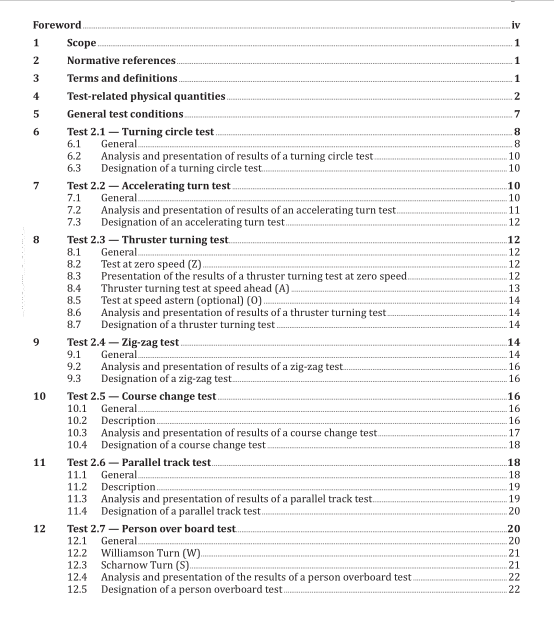ISO 13643-2-2013 pdf download.Ships and marine technology — Manoeuvring of ships — Part 2: Turning and yaw checking
This part of ISO 13643 defines symbols and terms and provides guidelines for the conduct of tests to give evidences about the turning ability and the yaw containment of surface ships, submarines, and models. It is intended that it be read in conjunction with ISO 13643-1.
2 Normative references
The following documents, in whole or in part, are normatively referenced in this document and are indispensable for its application. For dated references, only the edition cited applies. For undated references, the latest edition of the referenced document (including any amendments) applies.
ISO 13643-1, Ships and marine technology — Manoeuvring of ships — Part 1: General concepts, quantities and test conditions
ISO 13643-5, Ships and marine technology — Manoeuvring of ships — Part 5: Submarine specials
ISO 80000-1, Quantities and units— Part 1: General ISO 80000-3, Quantities and units — Part 3: Space and time
3 Terms and definitions
For the purposes of this document, the following terms and definitions apply.
3.1 turning circle test manoeuvring test to determine the ship’s turning characteristics due to application of manoeuvring devices during the period of transient motion and the ensuing steady turn depending on initial speed, rudder angle or equivalent, and direction of turn
3.2 accelerating turn test manoeuvring test to determine the ship’s behaviour when accelerating from stand-still and simultaneously applying the manoeuvring devices hard over
3.3 thruster turning test manoeuvring test to determine the capability to turn a ship at zero speed by using its thrusters and to determine the limiting speed at which no more turning effect from bow thrusters can be obtained Note 1 to entry: This test is relevant to all types and arrangements of tunnel- or azimuth-thrusters. However, dynamic positioning or traversing tests are beyond the scope of this part of ISO 13643.
3.4 zig-zag test manoeuvring test to determine the ship’s turning and yaw checking ability depending upon initial speed, the amount of manoeuvring devices effect applied, and execute change of heading at which the manoeuvring device is applied in the opposite direction (execute change of heading)
3.5 course change test
manoeuvring test to determine the ship’s capability to change heading by a given angle by use of the manoeuvring devices
3.6 parallel track test
manoeuvring test to determine the behaviour of the ship steering to a parallel track by applying manoeuvring devices and subsequently applying the manoeuvring devices in the opposite sense
3.7 person overboard test
manoeuvring test to determine the change of heading at which the ship is steered back to the reciprocal of its initial track by applying manoeuvring devices hard over
3.8 manoeuvring device
rudder, azimuthing thruster, hydroplane, cycloidal propeller, or equivalent system used to manoeuvre a vessel
3.9 hard over
application of the manoeuvring devices to their maximum designed effect
4 Test-related physical quantities
Test-related physical quantities are listed in Table 1. The more general quantities and concepts concerning the manoeuvring of ships are set out in ISO 13643-1.
For quantities and their units, ISO 80000-1 and ISO 80000-3 shall be used.
5 General test conditions
—The general test conditions in ISO 13643-1, Clause 8 shall be observed.
— When operating submerged, submarines shall be trimmed according to the results of the neutral level flight test (see ISO 13643-5, Clause 8). During the test, the dived depth must be kept as constant as possible. The dived depth and the plane angles are to be recorded continuously. If the submarine is equipped with planes acting into the horizontal as well as into the vertical direction at the same time (e.g. X-planes), these planes should be controlled in such a way that the dived depth is maintained with priority.
— During the test, including the approach phase, each successive position of the ship is to be recorded — e. g. using an onboard navigation system during surface operations — at suitable time intervals (usually every second).
— The reference point on the ship relative to which its track is measured should be defined in advance (e.g. location of the antenna). ISO 13643-2 pdf download.ISO 13643-2-2013 pdf download
